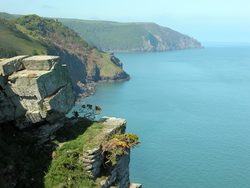
Exmoor National Park
Quick Navigation
Exmoor National Park is located along the northern side of the southwestern peninsula of England, United Kingdom. The park covers an area of 267 square miles (692 sq km).
The Bristol Channel is located to the north and the neighboring Dartmoor National Park is located almost directly south on the other side of the peninsula. The national park was historically renowned as the hunting grounds for the royal family.
The national park is comprised of the Brendon Hills, the coastline along the Bristol Channel, the East Lyn Valley, and the Vale of Porlock. The coastal shoreline covers a distance of 34 miles (55 km). There are a series of small villages scattered throughout the national park boundaries.
The upland landscapes give way to ravines, rolling hills, blanket mire, lowland heath, old woodlands, rivers, and waterfalls. The elevation varies in the park with the tallest point occurring at Dunkery Beacon at a height of 1,703 feet (519 m). The coastline displays aspects of the forest area, the rivers and waterfalls, and the ravines while also featuring rugged rock formations and cliffs.
Rivers are one of the key features of the park landscape with approximately 300 miles (483 km) of known rivers flowing throughout the national park. The park was named after the River Exe which flows south from Exe Head down to the English Channel. The majority of other rivers flow north toward the Bristol Channel making River Exe fairly unique.
The broad-leaf and conifer woodlands, moorland, heath, and grasslands support a variety of wildlife as well as some of the domestic livestock like sheep and cattle and the world’s oldest breed of pony. The most prominent larger species is the red deer which seems to be thriving quite nicely within the park’s boundaries.
The park is more known for its bird species with hundreds of species that either nest or migrate through the area. Merlin and Peregrine are two falcon species that often highlight sightings from the array of bird species found here in the park.
Highlights
Exmoor is an eclectic protected area providing visitors with a variety of natural features that enhance any outdoor adventure. It is a tremendous place to hike and explore. For many, the coastal shoreline is one of the most striking attractions of the park.
For some interested in history and culture, it is a highlight to be walking amongst the natural surroundings where historically kings and members of the royal family would visit for escapes into nature as well as royal hunting trips. Other cultural experiences include visiting the numerous small towns and villages presented throughout the national park borders.
Exmoor Coastline
 The coastal shoreline of Exmoor is characterized by rugged rock faces and jagged cliffs. Little Hangman is a cliff reaching a height of 656 feet (200 m) located at the boundary start of the national park. Exmoor presents a series of coastal hills and rugged rocky shoreline landscapes that reach up to 1,358 feet (414 m) at the point known as Culbone Hill.
The coastal shoreline of Exmoor is characterized by rugged rock faces and jagged cliffs. Little Hangman is a cliff reaching a height of 656 feet (200 m) located at the boundary start of the national park. Exmoor presents a series of coastal hills and rugged rocky shoreline landscapes that reach up to 1,358 feet (414 m) at the point known as Culbone Hill.
The larger waterfalls and caves add to the dramatic shoreline creating beautiful photographic landscapes. These astounding landscapes and striking features of the coastline have earned the area the Heritage Coast designation.
Lynton-Lynmouth Cliff Railway
The Lynton-Lynmouth Cliff Railway is a scenic railcar that travels uphill providing scenic views of the area below. The railway connects the two towns which are separated by a steep cliff.
It is the highest and steepest water-powered cliff rail-system in the world. Taking this ride between the two cities is both an opportunity to explore more of the natural world while also getting to experience a bit of history and culture.
Exmoor National Park Trails
Hiking in Exmoor National Park is one of the best ways to experience the natural splendor it has to offer to travelers who venture through the park. There are numerous hiking trails ready to help you explore the natural wonders of the park. Here are some of the favorites.
Park Protection
The national park protects the area that was historically set aside as the royal hunting grounds for the kings and royal family of England. While protecting this historical and cultural aspect of the area, really the park is protecting the wilderness and wildlife that attracted the royal families in the first place.
The park is also protecting the pristine Heritage Coast that features cliffs, caves, waterfalls, and a picturesque rugged coastal landscape. These are some of the most striking ravine, cliff, cave, and coastal landscapes in the country.
The protected varied vegetation is an investment in the hundreds of species of birds that nest and migrate through the park’s borders. Human encroachment is the biggest threat now that the area is under protected status.
Exmoor Highlights
- Walking amongst the kings
- Exmoor Coastline
- Lynton-Lynmouth Cliff Railway
Park Map
Sources
- All Trails, Best Trails in Exmoor National Park, https://www.alltrails.com/parks/england/somerset/exmoor-national-park, retrieved July 2020.
- Britannica, Exmoor National Park, https://www.britannica.com/place/Exmoor-National-Park, retrieved July 2020.
- Exmoor Magazine, Exmore National Park, https://www.exmoormagazine.co.uk/category/exmoor-national-park-news/, retrieved July 2020.
- Exmoor National Park, Government Site, https://www.exmoor-nationalpark.gov.uk/, retrieved July 2020.
- UNESCO, North Devon Biosphere Reserve, https://en.unesco.org/biosphere/eu-na/northdevon, retrieved July 2020.
- Visit Exmoor, Exmoor National Park, https://www.visit-exmoor.co.uk/, retrieved July 2020.









